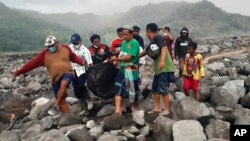For too many days now, Seniman has searched for his son, missing since the eruption of Indonesia’s Mount Semeru.
“I don’t have anything. I don’t have the means to search for my son by myself. I am confused. Where should I go to ask for help? I have been going back and forth between the search post and the police station,” said Seniman, a resident of Lumajang, an East Java district on the volcano’s slopes.
Seniman, who like many Indonesians uses only one name, told VOA Indonesia that his 19-year-old second child, Muhammad Hermansyah, was working in a sand mine when Mount Semeru erupted Dec. 4.
As of Friday, Hermansyah, along with two co-workers, are among more than a dozen people who are still missing since the eruption that killed dozens and coated at least 11 villages in the Lumajung district with volcanic ash.
“I’ll keep searching for him. Whatever his condition is, I hope that his body can be found so I can bring him home and pay him respect for the last time,” Seniman said, struggling to hold back tears. He carries his son’s identity card on his daily visit to the search command post.
Seniman’s wife remains in shock and collapses at the thought of her missing son. Seniman’s youngest child, an elementary school student, stays by her side. Seniman’s oldest child works outside Lumajang.
Authorities plan to continue searching for the missing until Tuesday, but the operation is likely to be hampered by the eruption’s aftermath, which includes hot gas and ash.
Seniman lives in Sumberwuluh village, one of the areas hardest hit by the eruption of Mount Semeru, which is one of almost 130 active volcanoes in Indonesia. It last erupted in December 2020, a frequency that is not unusual in a nation located on the “Ring of Fire” around the Pacific Ocean that is marked by active volcanoes and frequent earthquakes.
According to local authorities, 6,022 residents have been evacuated and are living in 115 shelters, mosques, schools and other safe buildings throughout the region.
Volunteers and evacuees have rallied to sort donations of food, clothing and medicines to ensure those with the greatest needs are assisted.
“We, the young volunteers, (are) ready to help the victims whenever a disaster comes,” said Muhammad Febrianto, who oversees a local volunteer group in Lumajang.
Volunteers are divided into several teams and spread across different shelters in Lumajang, he said.
“We work together from distributing foods and clothes that have been sent here. We hope that Lumajang and all the victims (from the eruption) will recover soon and may they have enough strength to continue their lives,” he added.
Lusiyanti, who uses only one name and works with the local Regional Disaster Management Agency, said only a limited number of volunteers work in the shelters as most have been deployed to assist the search and rescue team.
“We are overwhelmed, but fortunately, many residents come here to help. What makes it difficult is that the evacuees are spread across Lumajang,” she said, adding that a shortage of baby formula is making the situation worse for many.
As of Wednesday, at least 39 people were reported dead. Data from Lumajang’s disaster management agency recorded that the eruption also destroyed 2,970 resident houses and killed 3,026 livestock. Forty-two school buildings, 17 houses of worship, one health facility and one bridge were also destroyed.










